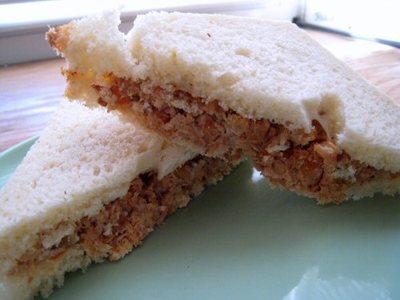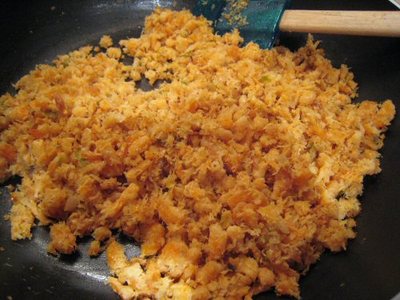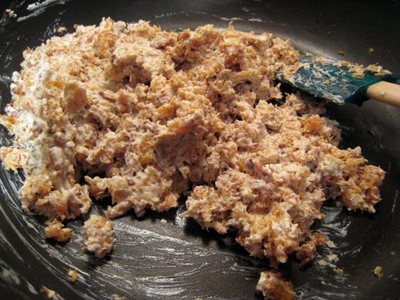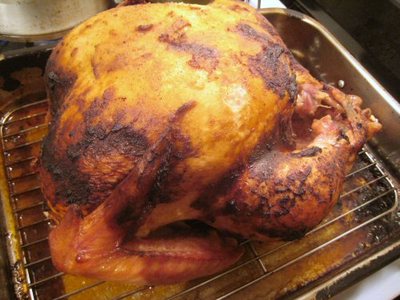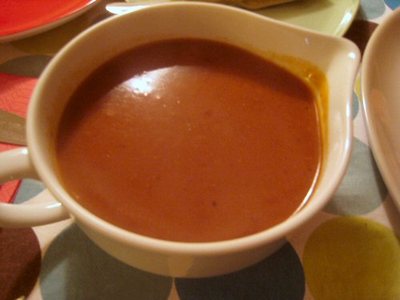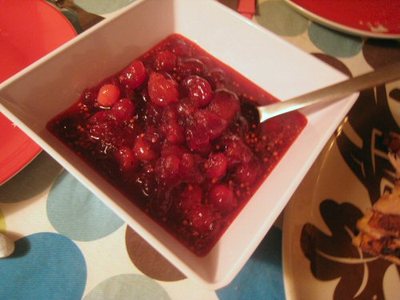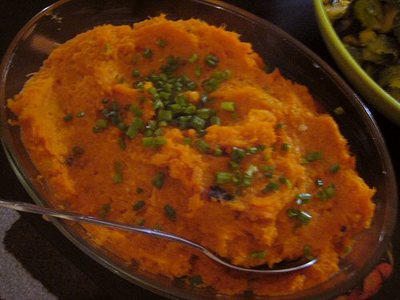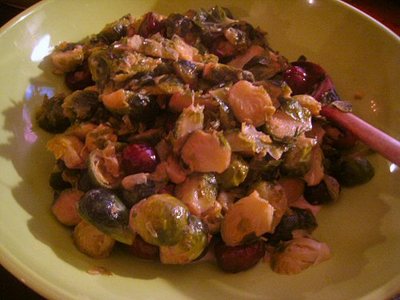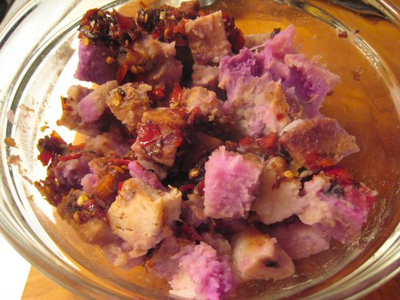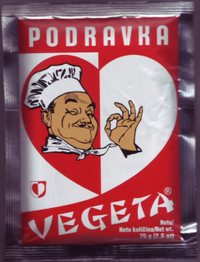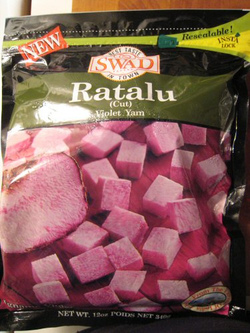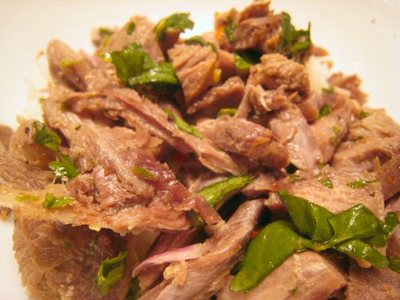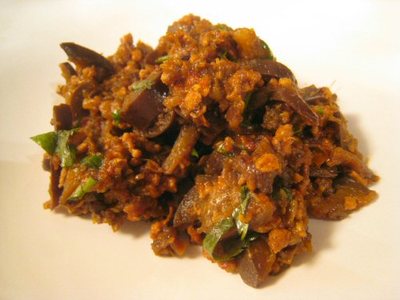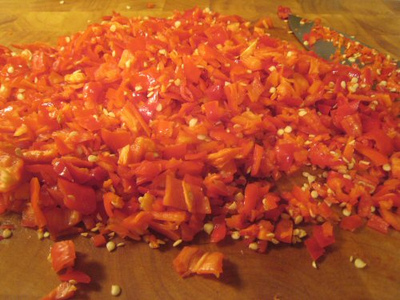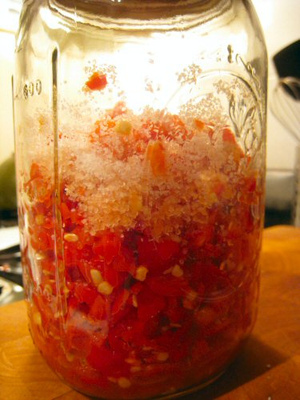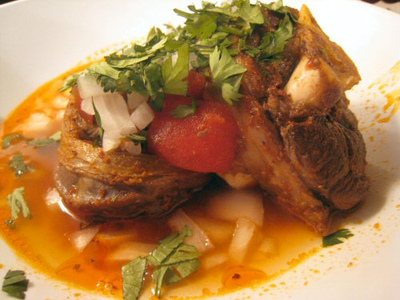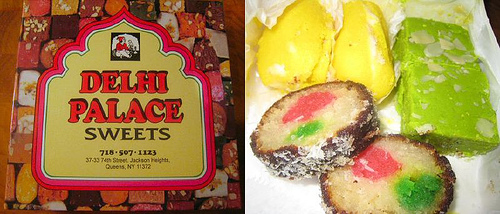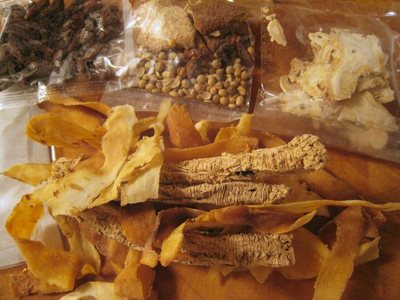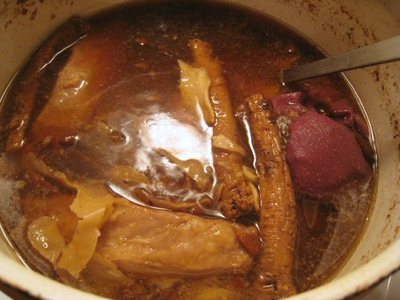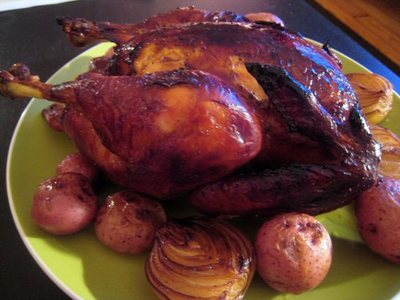
Don't you love the television's blue glow?
I feel funny using recipe titles when they include someone’s name, mostly because it seems overly familiar when you don’t know the person being honored. So, this Penang-style roast chicken from James Oseland’s Cradle of Flavor is technically called Kevin’s Spiced Roast Chicken with Potatoes, Penang Style. Thanks, Kevin.
I don’t know why Eurasian food seems fitting for the holidays, it’s not as if I raised cross-culturally. I think my lack of culinary traditions means that I can substitute whatever I’d like for Christmas dinner. As I mentioned in my previous post, I originally thought of devil curry, a Portuguese-Malay mishmash that often includes canned sausages, but then I realized that I had already made it in 2005. I guess it wasn’t that memorable. To be honest, it was kind of bland and not worth tinkering with in 2007.
Another Eurasian holiday dish curry feng sounds fascinating to an organ meat lover like myself. But lungs aren’t even legal to eat in the U.S. (the recipe I found from Rasa Malaysia calls for lungs, though most others I’ve found do not) and there’s something mildly gruesome about sitting alone chewing on stomach, hearts, intestines, liver and whatever else is in this curry. Kidneys are meant to be shared.
This year I’m unusually lazy even though I have free time galore. I wanted Southeast Asian food without much fuss. Sometimes it’s fun to scour the city for ingredients and spend time chopping and pounding. Sometimes you just can’t be bothered. The only component the average American might not have on hand for this recipe is the kecap manis. I could kick myself for tossing out a bottle a few months ago (instead of a plastic top it had a bottle cap and the crinkled up piece of foil I’d been using to stop it up started to gross me out).
But heading to Chinatown (which is only four subway stops from my apartment, so no complaints) would allow me to pick up some sides. I’m normally all for an everything from scratch approach, but when you’re cooking for one hardcore details can slide. You only have to please yourself. Why make pickles from scratch when sliced sweet and sour turnips and carrots are only $2.29? I like a crunchy, tangy condiment with roast meat, especially Asian-influenced preparations.
Pungent, sweet and spicy shrimp paste encrusted green beans interspersed with whole shrimp were a perfect side for an East-West entrée. Lady fingers (okra) or petai (stink beans) might’ve been uber Malaysian, and they were available from Skyway where I made my purchase, but green beans made more sense in this context. No need to be un-American.

We buy most of our meat from Western Beef because it’s cheap, they have every cut from every animal imaginable, and we’re not caught up enough with organics or free range ethics to have a problem with grocery store flesh. So, the $1.99/lb “fresh young chicken” at Hong Kong Supermarket actually seemed kind of pricey, but I only needed a little guy, 3.5 pounds. I noticed at the check out counter that the chicken was whole, head on, which I’ve never dealt with before.
I’m not squeamish about animals as food (though I certainly don’t want to hang out in slaughterhouses, I don’t understand grown ups who get freaked out by meat with bones. I’ve known many non-vegetarians who can’t cook chicken because skin, veins and bones creep them out) but I was a little perplexed by the head. I’ve never had to chop one off (I wasn’t even sure I was supposed to, but this recipe was unusually specific and said to remove head, feet and cavity fat) so I guess I’m sheltered. Even Kid Nation participants had to kill chickens. I felt bad because I don’t have a cleaver and had to saw the poor thing’s neck.

Then, I realized it still had legs and feet. I eat chicken feet, no problem but I don’t think the dim sum comes with tiny toenail claws. There were still quite a few feathers left on the bird, too. I learned more about chicken parts this Christmas Eve than I’d anticipated. The tag on the chicken’s wing indicated that it came from my old stomping grounds, Greenwood Heights (yes, I always called it Sunset Park but I’m trying to be un-anal and modern). There are a lot of live poultry markets over there, but I’ve never had the nerve to patronize one.
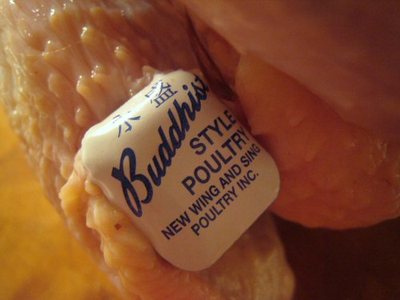
I love it when recipes I’ve taken from books are already published on the internet. It saves me tedious typing and the bad karma associated with violating copyright. I’m pleased to see that Salon published this recipe and a few others, too. This is a very good cookbook–one of 2006’s best–that I never ever cook from for absolutely no reason at all.
Kevin's Spiced Roast Chicken with Potatoes, Penang Style
1 whole free-range chicken, 3 1/2 pounds (1.4 kilograms)
1/3 cup (2 1/2 fluid ounces/75 milliliters) soy sauce
2 tablespoons double-black soy sauce
1 teaspoon Worcestershire sauce
3 bay leaves
2 pieces cinnamon stick, each 4 inches (10 centimeters) long
6 whole cloves
5 small red or yellow onions (about 1 pound/455 grams total), each no more than 2 1/2 inches (6 centimeters) long, halved
1 1/2 teaspoons coarsely crushed black pepper
2 tablespoons unsalted butter, softened
1 1/2 pounds (680 grams) small potatoes such as Yukon Gold, Peruvian blue, or Maine, no more than 1 1/2 inches (4 centimeters) in diameter
1. Remove and discard the fat inside the chicken (reserve the head and feet to use in stock if they were attached). Rinse the chicken and thoroughly pat it dry inside and out with paper towels. Tuck the wingtips behind the shoulders.
2. Place the chicken in a bowl large enough to hold it comfortably. Pour both soy sauces and the Worcestershire sauce over it. Add the bay leaves, cinnamon sticks, cloves, and onions. Using your hands or a large spoon, turn the chicken a few times, making sure that some of the liquid, spices, and a few onion halves are slipped inside the cavity. Rub the inside and outside of the chicken with the pepper. Let the chicken marinate, uncovered, at room temperature for 1 to 2 hours. Turn the bird over every 15 minutes or so to distribute the marinade evenly. Its skin will darken a few shades from the soy sauces.
3. Toward the end of the marinating, preheat the oven to 450°F (220°C).
4. Place the chicken, breast side up, in a shallow roasting pan. Scatter the onions around the chicken, making sure that 1 or 2 halves remain inside the cavity. Rub the chicken inside and out with the softened butter. (I like to rub some underneath the breast skin as well, which helps make the breast meat juicier.) Pour the remaining marinade over the chicken, placing the cinnamon sticks and a few of the cloves inside the cavity. Cover the pan loosely with aluminum foil.
5. Roast the chicken for 20 minutes, then turn it over. Tilt the pan toward you and, using a large spoon or baster, baste the chicken and its cavity with the pan juices. Cover the pan once more with the foil and continue roasting for another 20 minutes.
6. Meanwhile, scrub the potatoes but don't peel them. Fill a 3-quart saucepan three-fourths full with water and bring to a boil over high heat. Add the potatoes and cook at a rolling boil until they are just tender when pierced with a fork, 5 to 10 minutes. Drain the potatoes well in a colander.
7. Add the cooked potatoes to the roasting pan. Combine them gently with the onions already in the pan and baste them well with the pan juices. Turn the chicken over again (it should be breast side up this time) and baste it once more. Continue roasting the chicken, uncovered now so that it can brown just a bit, until it's cooked. The total cooking time will range from 1 hour and 10 minutes to 1 1/2 hours. To test for doneness, using a fork, pierce the skin at the thigh joint and press down gently. The juices should have only the faintest tinge of pink. Or, you can insert an instant-read thermometer into the thickest part of the thigh, not touching the bone. The chicken is ready when the thermometer registers 170°F (75°C).
8. Place the chicken on a serving platter. Pour half of the pan juices over it and allow the chicken to rest for at least 10 minutes before carving (this allows time for the juices to be absorbed by the flesh). Place the potatoes and onions around the chicken or in a serving bowl. Pour the remaining pan juices over the potatoes and onions. This chicken is best when served slightly warm. The flavors will be more pronounced and the flesh juicier.
Serves 4
The finished product turned out crispy and burnished from the molasses-based soy. The flavor was only slightly Asian, and not terribly Malaysian; the cloves and cinnamon almost felt Moroccan. I rounded out the chicken with potatoes, onions, my sweet and sour turnips and shrimp studded green beans.
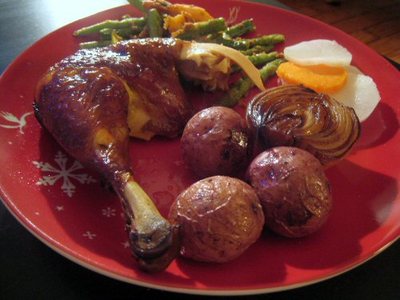
Since I didn’t end up dining until 1am, technically Christmas day when I was going for an Eve supper, I wasn’t hungry enough to appreciate all the food. Um, and I’d just about polished off a bottle of Charles Shaw Shiraz by the time all was said and done so I’d lost a bit of my original focus. But I expect to fully enjoy my leftovers over the next few nights.


 Follow
Follow

